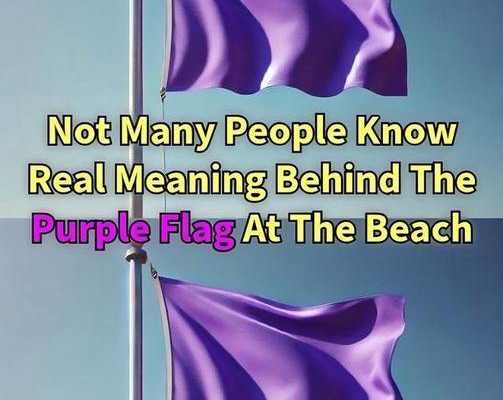As a dedicated beachgoer, I’ve spent countless sunny days soaking up the sun, building sandcastles, and wading in the waves. The salty air, crashing surf, and warm sand are my ultimate escape. But on a recent visit, something unusual caught my eye—a purple flag waving in the wind. While we’re all used to seeing green flags for safe conditions, yellow for caution, and red for rough waters, this purple flag was unfamiliar. If you’ve ever wondered what it means, here’s the answer.

Decoding Beach Flag Warnings
Imagine arriving at the beach, ready for a perfect day. You glance at the flags along the shore to check the water conditions: green means it’s all clear, yellow suggests some caution, and red warns of dangerous waters. But a purple flag? This color isn’t as well-known, adding a layer of mystery to the beach experience. The meaning behind it, however, is vital for safety.
What the Purple Flag Means
After a bit of research, I found that the purple flag serves as a specific alert. Unlike other flags that signal water conditions, the purple flag warns beachgoers about the presence of potentially dangerous marine life. When you see a purple flag, it’s letting you know that jellyfish, stingrays, or other marine pests might be nearby. Essentially, it’s a caution from the ocean itself, advising you to take extra care.
Marine Pests and What to Watch Out For
If you see a purple flag, it’s a sign that there might be some “uninvited guests” in the water. Jellyfish, with their stinging tentacles, are one of the most common marine creatures flagged by this signal. But stingrays or other potentially harmful sea life could also be present. While the ocean remains inviting and beautiful, the purple flag is a reminder to stay alert and mindful of these creatures.
A Quick Guide to Other Beach Flags
It’s also helpful to review the meanings of the other beach flags so that you’re fully informed:
- Green Flag: Indicates calm waters and safe swimming conditions.
- Yellow Flag: Signifies moderate hazards, so exercise caution before diving in.
- Red Flag: High hazard, with rough or dangerous waters—only experienced swimmers should consider entering.
- Double Red Flag: Water is off-limits due to extreme danger, and swimming is prohibited.
Each of these flags plays a crucial role in ensuring beachgoers stay informed and safe. Knowing their meanings can help you make smart decisions when planning a day at the shore.
Why the Purple Flag Matters
The purple flag carries an important message: “Be cautious—marine pests may be present.” It’s a reminder that the ocean is not just about sand and waves but also a habitat for diverse marine life. These creatures play essential roles in the ecosystem, and the flag encourages us to share the ocean space responsibly and safely.
How to Stay Safe When You See a Purple Flag
If you encounter a purple flag, here are some steps to stay safe:
- Stay Informed: Check in with lifeguards or beach officials about what specific marine animals might be in the area.
- Be Cautious: If you decide to swim, stay aware, especially in shallow areas where stingrays might be hiding.
- Protect Yourself: Consider wearing protective clothing like rash guards or using anti-jellyfish creams to help prevent stings.
- Spread Awareness: Let others know what the purple flag means so that everyone can stay safe.
Respecting the Ocean’s Signals
The purple flag is a reminder that the ocean, though inviting, is also home to creatures that deserve our caution and respect. Jellyfish, stingrays, and other marine animals are vital to the ocean’s ecosystem. By understanding their presence, we can enjoy the beach more safely and respectfully, keeping both us and the marine environment in mind.
Conclusion: A Helpful Warning from the Ocean
The next time you see a purple flag on the beach, remember that it’s the ocean’s way of saying, “Welcome, but be aware.” This flag helps us appreciate both the beauty and potential risks of the sea. By understanding the beach flag system, we can make the most of our time in the sun while staying safe and well-informed. So enjoy your beach day, and let the flags guide you to a safer, more enjoyable



